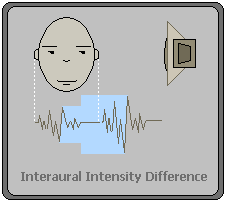 |
|
|
|
In the Forums... |
Posted: April 10, 2000 Written by: Tuan "Solace" Nguyen Positional 3D Audio 3D Sound in 3D Space The way in which 3D sound works on a PC requires intensive mathematical computations. The software developer must specify where the sound source is located and where the listener is located in X, Y and Z coordinates. Other parameters that they must consider are the direction that the listener is facing in regards to the sound source, the velocity of the sound source, and the way it radiates - conically or spherically. But to first understand how these sound APIs work and how 3D sound works, we're gonna tell you how your ears work. Head Related Transfer Functions There are two main clues that help us identify where a sound is emitting from: Intensity (IID) of Delay (ITD). This means that if a sound source is on your left, then your left ear will hear it louder and sooner than your right ear. It is also interesting to know that the shape of your outer ear helps the brain more accurately define the sound's location in space. Other factors that help localize a sound are head shadow and shoulder bounce, which also alter the sound. We also hear high frequencies better than low ones. This is why it is important to place certain speakers in certain positions. Your subwoofer can be place anywhere because your ears cannot tell which direction the bass is coming from. However, your satellites, being able to create almost the entire sound spectrum must be placed accordingly to where you are.  How HRTFs were designed is relatively simple. Researchers placed a dummy head into an echo free room and installed microphones into the ear canals. Then the sound source was moved around the head at a constant distance from the head. The difference between the acoustic spectral responses in both ears were measured and recorded. The set of these measurements is called a Head Related Transfer Function (a mathematical representation of how the human ear perceives sound). It is composed of three parts: near-ear response, far-ear response and Interaural Time Difference (the time difference between the near and far ear.) This process is repeated for different head sizes and ear sizes to come to a generalized HRTF model suitable for a wide range of audiences. Piping a sound signal through a HRTF filter should make the sound appear to originate from the location of that specific filter. For example, a sound that is passed through a HRTF filter that was measured for 145 degrees behind you will make it seem as though it were there. HRTFs alone cannot produce sounds positioned accurately if a signal intended for your left ear is also heard by your right through the left speaker. Developers must also add transaural crosstalk cancellation signals to keep the sound from reaching the opposite ear. These signals are usually inverse waveforms of the original waveform. |
||
|
| |||
|---|---|---|---|